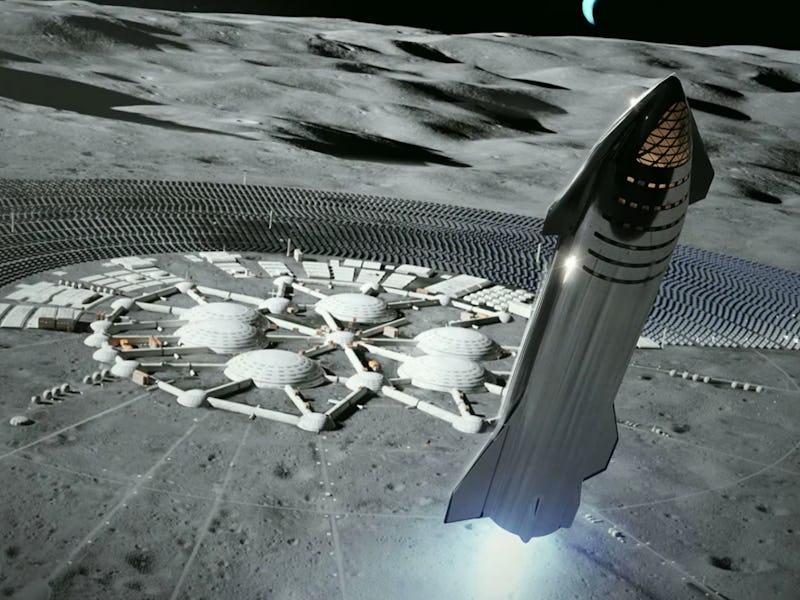SpaceX Starship: This new hurdle stands between Musk and his Mars City
SpaceX's under-development rocket is designed to take humans to Mars. When it will do so is another question.

SpaceX’s rocket launch facility is taking shape — but perhaps not fast enough for the company’s most ambitious goals.
Last week, the Federal Aviation Administration announced it sought public input on SpaceX’s proposed Starship and Super Heavy rocket program. SpaceX designed the under-development rocket to send up to 100 people or 100 tons into space at a time and possibly to send the first humans to Mars.
But before SpaceX can soar to Mars, it has to clear some regulatory hurdles. That could put an end to CEO Elon Musk’s goal to host the first orbital flight this year, and it may draw into question the company’s longer-term deadlines to carry NASA astronauts to the Moon in 2024, send humans to Mars by the mid-2020s, and establish a Mars city by 2050.
In Musk’s race to make humanity into a multi-planetary species, these hurdles could represent some speed bumps on the way.
Want to find out more about Musk’s plans for Mars? Subscribe to MUSK READS+ for exclusive interviews and analysis about spaceflight, electric cars, and more.
SpaceX Starship: What is it?
Musk first unveiled the predecessor to the ship in 2017. SpaceX designed the fully-reusable rocket to cover missions currently handled by the Falcon 9 and Falcon Heavy while enabling more ambitious missions.
The ship uses liquid oxygen and methane as its fuel — meaning that, in theory, astronauts will be able to go to Mars, use the planet’s natural resources to generate more fuel, and use that to return home — or possibly venture out further.
In May 2021, a document from the Federal Communications Commission showed that the company planned to launch the rocket on an orbital test flight in the second half of this year.
A prototype of the ship portion of SpaceX’s Starship.
SpaceX Starship: What the FAA wants
The FAA has released a draft environmental review of SpaceX’s program in Boca Chica, Texas, and it’s now hosting a 30-day public comment period that ends on October 18. The FAA is clear:
“SpaceX cannot launch the Starship/Super Heavy vehicle until the FAA completes its licensing process, which includes the environmental review and other safety and financial responsibility requirements.”
The FAA is looking to complete four steps:
- To finalize a draft programmatic environmental assessment or PEA, an analysis of how the environment around the site will be affected by SpaceX’s plans, viewable here.
- To ask the public to comment on this draft during a 30-day period that ends on October 18.
- Allow SpaceX to develop the program further which, along with the draft PEA, will be used to consider the future environmental impact.
- Evaluate the comments and draft PEA to decide if the environmental impact would be significant. If so, it would conduct an Environmental Impact Statement.
The FAA’s draft PEA paints a positive picture. In the summary of environmental consequences, the agency does not expect a significant impact in any of the listed categories — in other words, it’s not likely to have a big effect on the nearby environment.
SpaceX Starship: What this means for the launch schedule
Teslarati notes that an orbital launch in 2021 now seems unlikely.
The FAA first announced the start of the environmental review back in November 2020. George Nield, a former FAA associate administrator, told Business Insider that environmental assessments take three to four months. But nearly a year later, the FAA has just released the draft document.
SpaceX’s chances of getting all the clearances before the end of the year look slim, pushing back the company’s orbital test timeline further.
Jonathan Hofeller, SpaceX vice president of commercial sales, claimed in July 2019 that the goal was to potentially reach orbit in 2019 before completing the first commercial launch in early 2021. In September of that year, Musk claimed an orbital flight could happen within months.
SpaceX has two major Starship missions scheduled for the near future. One is the “dearMoon” flight announced in 2018, which will send Japanese billionaire Yusaku Maezawa and a team of eight other civilians on a trip around the Moon in 2023
The other is NASA’s Artemis mission. The Starship is expected to serve as the human lander for the agency’s first crewed mission to the Moon since 1972. Although expected for 2024, Musk has suggested this could happen sooner.
But to carry astronauts from the Orion spacecraft to the Moon’s surface, the Starship will have to go to the Moon first. That means SpaceX will have to get to orbit.
Artist's impression of the Starship landing on Mars.
Beyond that, SpaceX aims to send the first humans to Mars by the mid-2020s, possibly around 2026.
From there, the goal is to establish a self-sustaining city on the planet by 2050, which Musk estimates would require around one million tons of cargo. Musk claimed in 2019 that SpaceX could build the city over 10 orbital synchronizations.
In other words, when Earth and Mars are at their closest every 26 months, SpaceX would launch a fleet of rockets. Doing this 10 times means SpaceX could build the city in around 22 years, which means it would have to send the first fleet of rockets around 2028.
The race is on.
SUBSCRIBE TO MUSK READS+, A PREMIUM NEWSLETTER THAT COVERS THE WORLDS OF ELON MUSK, SPACEX, TESLA, AND EVERYTHING BETWEEN.